Discount treasure-hunt retailer Dollar Tree (NASDAQ:DLTR) reported results in line with analysts' expectations in Q4 FY2023, with revenue up 11.9% year on year to $8.64 billion. The company expects next quarter's revenue to be around $7.75 billion, slightly above analysts' estimates. It made a GAAP loss of $7.85 per share, down from its profit of $2.04 per share in the same quarter last year.
Dollar Tree (DLTR) Q4 FY2023 Highlights:
- Revenue: $8.64 billion vs analyst estimates of $8.65 billion (small miss)
- EPS: -$7.85 vs analyst estimates of $2.65 (-$10.50 miss) ($1.1 billion impairment charge)
- Management's revenue guidance for the upcoming financial year 2024 is $31.5 billion at the midpoint, missing analyst estimates by 0.7% and implying 2.9% growth (vs 7.9% in FY2023)
- Management's EPS guidance for the upcoming financial year 2024 is $7.00 at the midpoint, missing analyst estimates of $7.07 by 1.0%
- Gross Margin (GAAP): 32.2%, up from 31% in the same quarter last year
- Free Cash Flow of $470.8 million, down 14.8% from the same quarter last year
- Same-Store Sales were up 3% year on year (slight beat)
- Store Locations: 16,774 at quarter end, increasing by 434 over the last 12 months
- Market Capitalization: $32.61 billion
A treasure hunt because there’s no guarantee of consistent product selection, Dollar Tree (NASDAQ:DLTR) is a discount retailer that sells general merchandise and select packaged food at extremely low prices.
Founded in 1986 and initially selling items priced at $1 or less, the company has since expanded its selection and price points. However, most items are still under $5 with an extensive selection under $2.
While low prices are an obvious benefit to the consumer, the tradeoff is consistency of selection. One day, a shopper may find bottles of name-brand dish soap for $1 that would sell for much more elsewhere. However, that product may not be available weeks later. This is why the Dollar Tree experience is often called a treasure hunt. The company’s sourcing and logistics capabilities are a key reason prices are so low. Shorter-term deals and arbitrage opportunities are prioritized by the merchandising team over long-term supplier agreements.
Dollar Tree is known for party supplies, holiday décor, home goods, toys, and a limited snack selection, but the company also operates the Family Dollar banner. Acquired in 2015, Family Dollar focuses more on food and consistent selection to serve the grocery needs of lower-income households. The concept competes most directly with Dollar General and looks to locate stores in rural or suburban areas not served well by large regional grocery chains or general merchandise behemoths like Walmart.
Discount Grocery Store
Traditional grocery stores are go-tos for many families, but discount grocers serve those who may not have a traditional grocery store nearby or who may have different spending thresholds. Certain rural or lower-income areas simply don’t have a grocery store. Additionally, some lower-income families would prefer to buy in smaller quantities than available at most stores (think one or two paper towel rolls at a time). While online competition threatens all of retail, grocery is one of the least penetrated because of the nature of buying food. Furthermore, those buying small quantities for immediate need are even less likely to leverage e-commerce for these purposes.
Competitors that offer a treasure-hunt experience centered around general merchandise and/or snacks include Five Below (NASDAQ:FIVE), Dollarama (TSX:DOL), and TJX (NYSE:TJX).Sales Growth
Dollar Tree is one of the larger companies in the consumer retail industry and benefits from economies of scale, enabling it to gain more leverage on fixed costs and offer consumers lower prices.
As you can see below, the company's annualized revenue growth rate of 6.7% over the last four years (we compare to 2019 to normalize for COVID-19 impacts) was weak , but to its credit, it opened new stores and grew sales at existing, established stores.
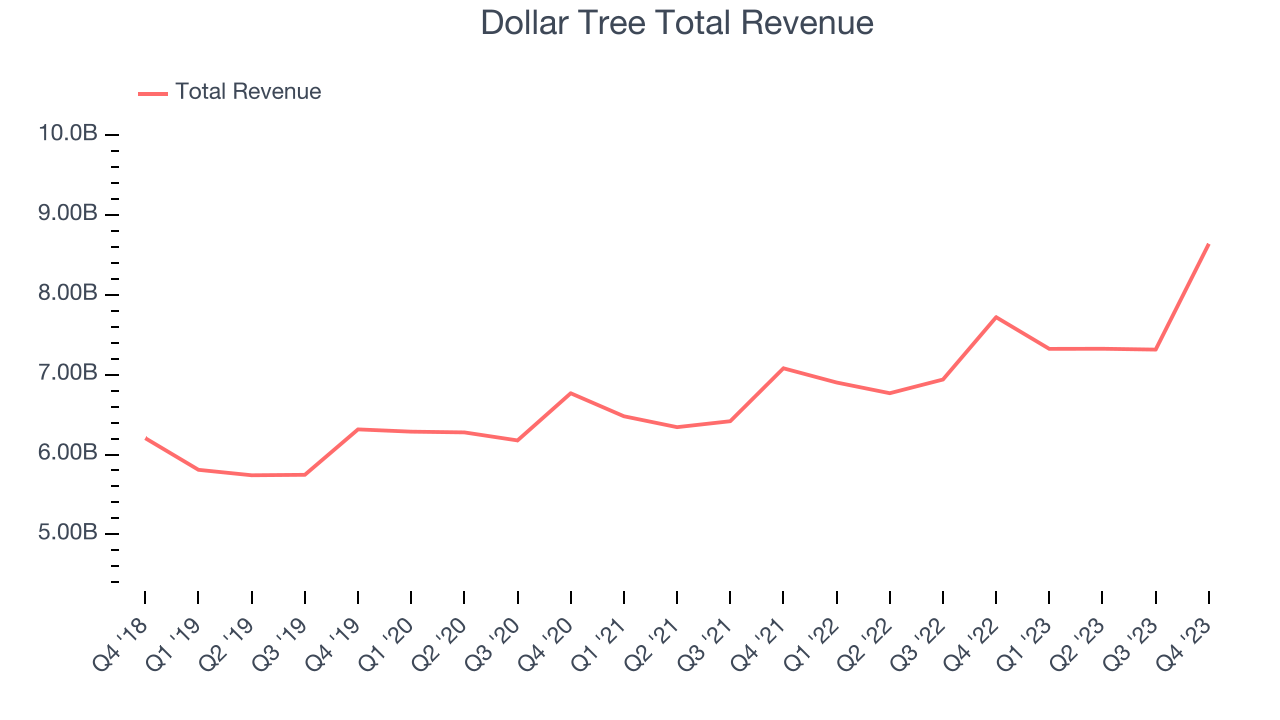
This quarter, Dollar Tree's revenue grew 11.9% year on year to $8.64 billion, falling short of Wall Street's estimates. The company is guiding for revenue to rise 5.8% year on year to $7.75 billion next quarter, in line with the 6.1% year-on-year increase it recorded in the same quarter last year. Looking ahead, Wall Street expects sales to grow 3.5% over the next 12 months, a deceleration from this quarter.
Number of Stores
When a retailer like Dollar Tree keeps its store footprint steady, it usually means that demand is stable and it's focused on improving operational efficiency to increase profitability. Since last year, Dollar Tree's store count increased by 434 locations, or 2.7%, to 16,774 total retail locations in the most recently reported quarter.
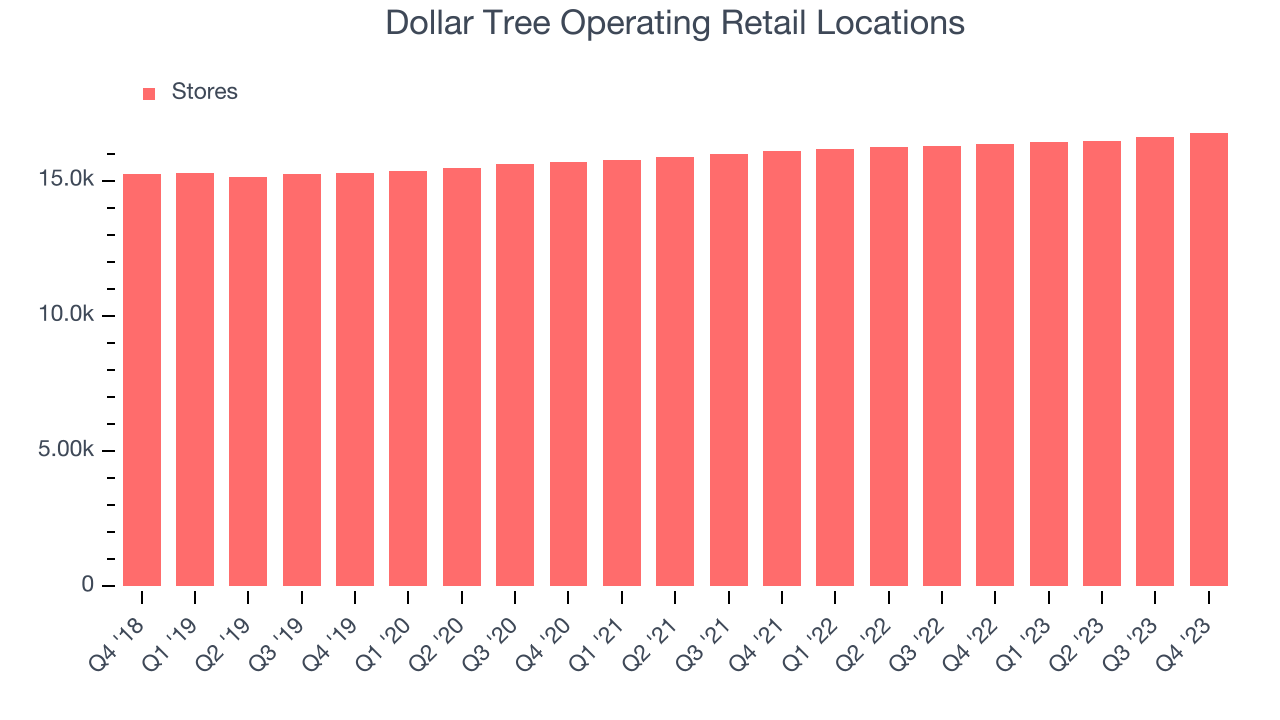
Over the last two years, the company has only opened a few new stores, averaging 2% annual growth in new locations. This sluggish pace lags the broader sector. A flat store base means that revenue growth must come from increased e-commerce sales or higher foot traffic and sales per customer at existing stores.
Same-Store Sales
Same-store sales growth is a key performance indicator used to measure organic growth and demand for retailers.
Dollar Tree's demand within its existing stores has generally risen over the last two years but lagged behind the broader consumer retail sector. On average, the company's same-store sales have grown by 5.2% year on year. With positive same-store sales growth amid an increasing physical footprint of stores, Dollar Tree is reaching more customers and growing sales.
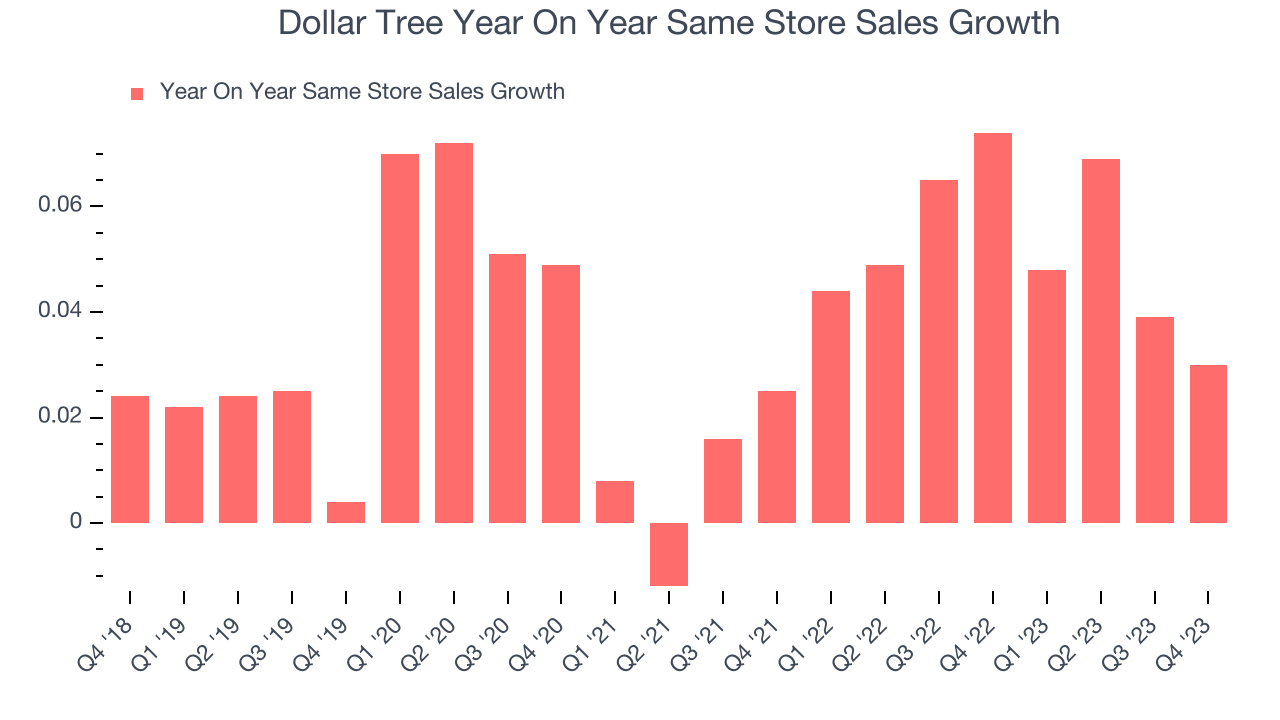
In the latest quarter, Dollar Tree's same-store sales rose 3% year on year. By the company's standards, this growth was a meaningful deceleration from the 7.4% year-on-year increase it posted 12 months ago. We'll be watching Dollar Tree closely to see if it can reaccelerate growth.
Gross Margin & Pricing Power
Dollar Tree has weak unit economics for a retailer, making it difficult to reinvest in the business. As you can see below, it's averaged a 31% gross margin over the last eight quarters. However, when comparing its margin specifically to other non-discretionary retailers, it's actually pretty solid. That's because non-discretionary retailers have structurally lower gross margins as they compete to provide the lowest possible price, sell products easily found elsewhere, and have high transportation costs to move their goods. We believe the best metrics to assess these types of companies are free cash flow margin, operating leverage, and profit volatility, which take their scale advantages and non-cyclical demand characteristics into account.
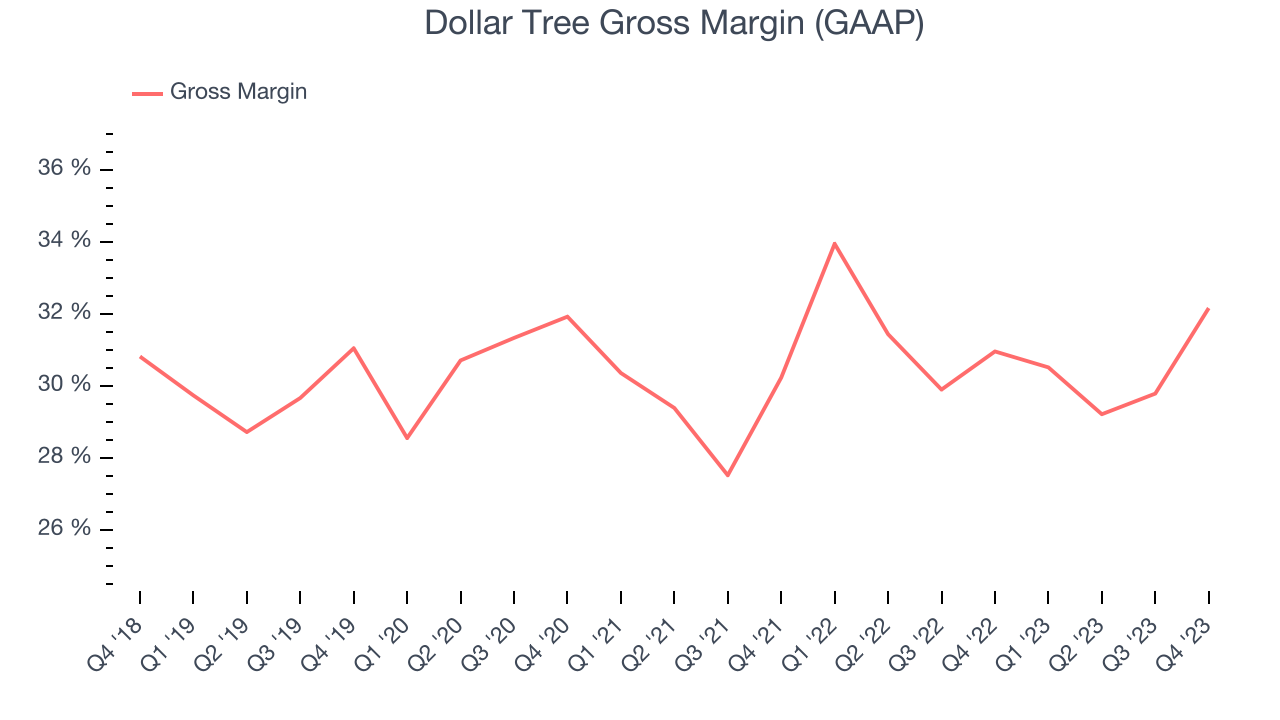
Dollar Tree produced a 32.2% gross profit margin in Q4, marking a 1.2 percentage point increase from 31% in the same quarter last year. This margin expansion was particularly strong for a retailer like Dollar Tree, which is structurally less profitable than the typical retail business for the reasons mentioned above, as it signals a less competitive environment with more stable input costs (such as freight expenses to transport goods) and less pressure to discount products.
Operating Margin
Operating margin is a key profitability metric for retailers because it accounts for all expenses keeping the lights on, including wages, rent, advertising, and other administrative costs.
This quarter, Dollar Tree generated an operating profit margin of negative 21.9%, down 30.4 percentage points year on year. Note that the unusually low GAAP operating profit was due to a $1.1 billion non-recurring impairment charge.
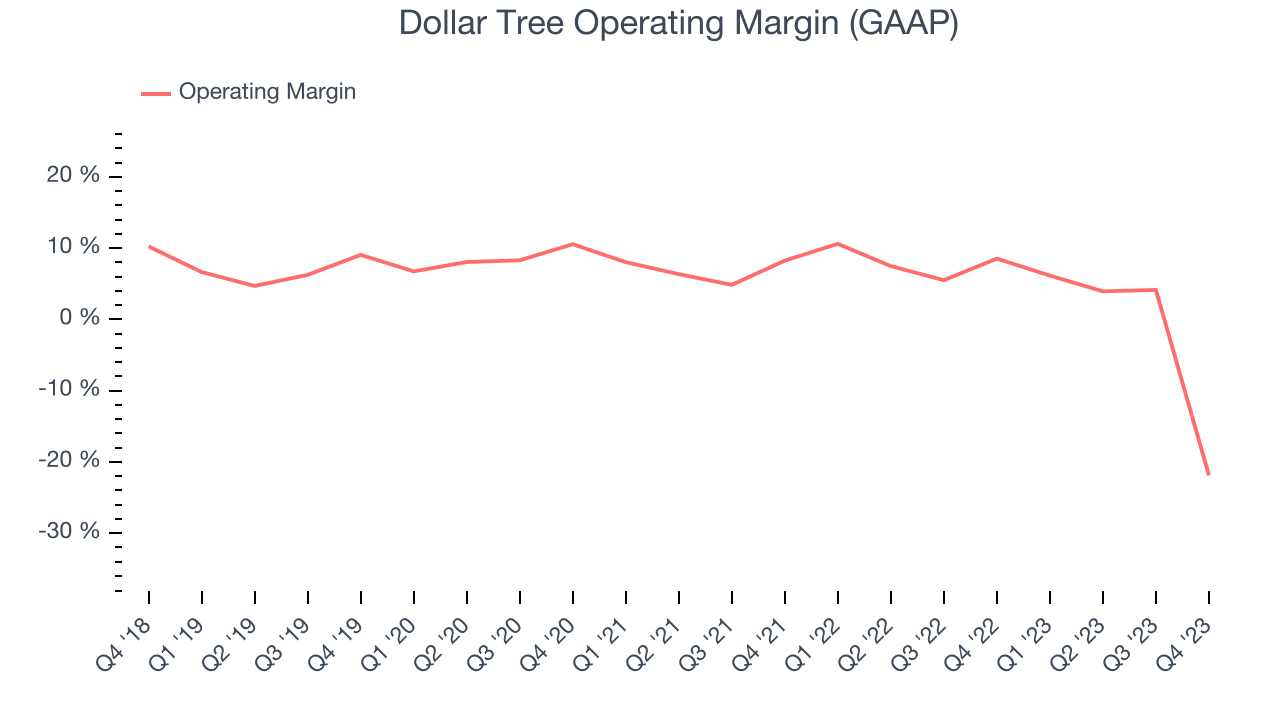
Zooming out, Dollar Tree was profitable over the last two years but held back by its large expense base. Its average operating margin of 2.4% has been paltry for a consumer retail business. On top of that, Dollar Tree's margin has declined, on average, by 10.8 percentage points year on year. This shows the company is heading in the wrong direction, and investors were likely hoping for better results.
EPS
Earnings growth is a critical metric to track, but for long-term shareholders, earnings per share (EPS) is more telling because it accounts for dilution and share repurchases.
In Q4, Dollar Tree reported EPS at negative $7.85, down from $2.04 in the same quarter a year ago. Note that the unusually low GAAP EPS was due to a $1.1 billion non-recurring impairment charge. This print unfortunately missed Wall Street's estimates, but we care more about long-term EPS growth rather than short-term movements.
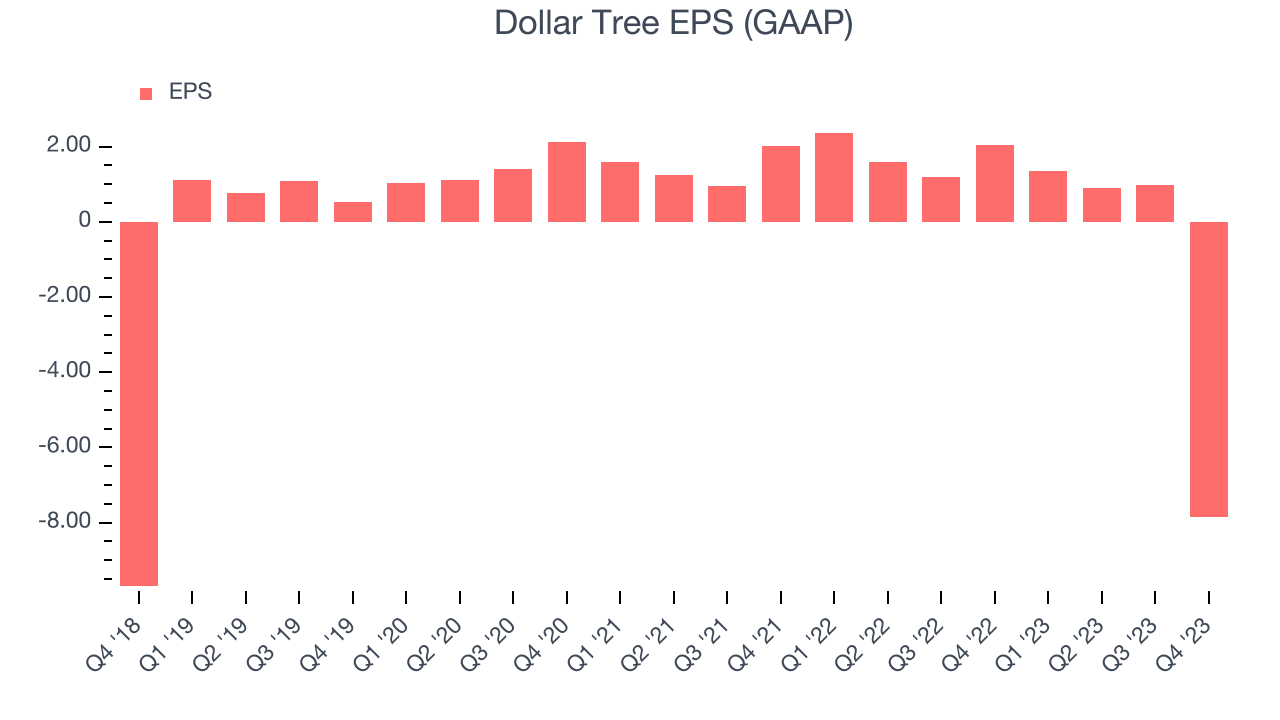
Between FY2019 and FY2023, Dollar Tree's adjusted diluted EPS dropped 82.2%, translating into 35.1% annualized declines. In a mature sector such as consumer retail, we tend to steer our readers away from companies with falling EPS. If there's no earnings growth, it's difficult to build confidence in a business's underlying fundamentals, leaving a low margin of safety around the company's valuation (making the stock susceptible to large downward swings).
On the bright side, Wall Street expects the company's earnings to grow over the next 12 months, with analysts projecting an average 253% year-on-year increase in EPS.
Cash Is King
Although earnings are undoubtedly valuable for assessing company performance, we believe cash is king because you can't use accounting profits to pay the bills.
Dollar Tree's free cash flow came in at $470.8 million in Q4, down 14.8% year on year. This result represents a 5.4% margin.
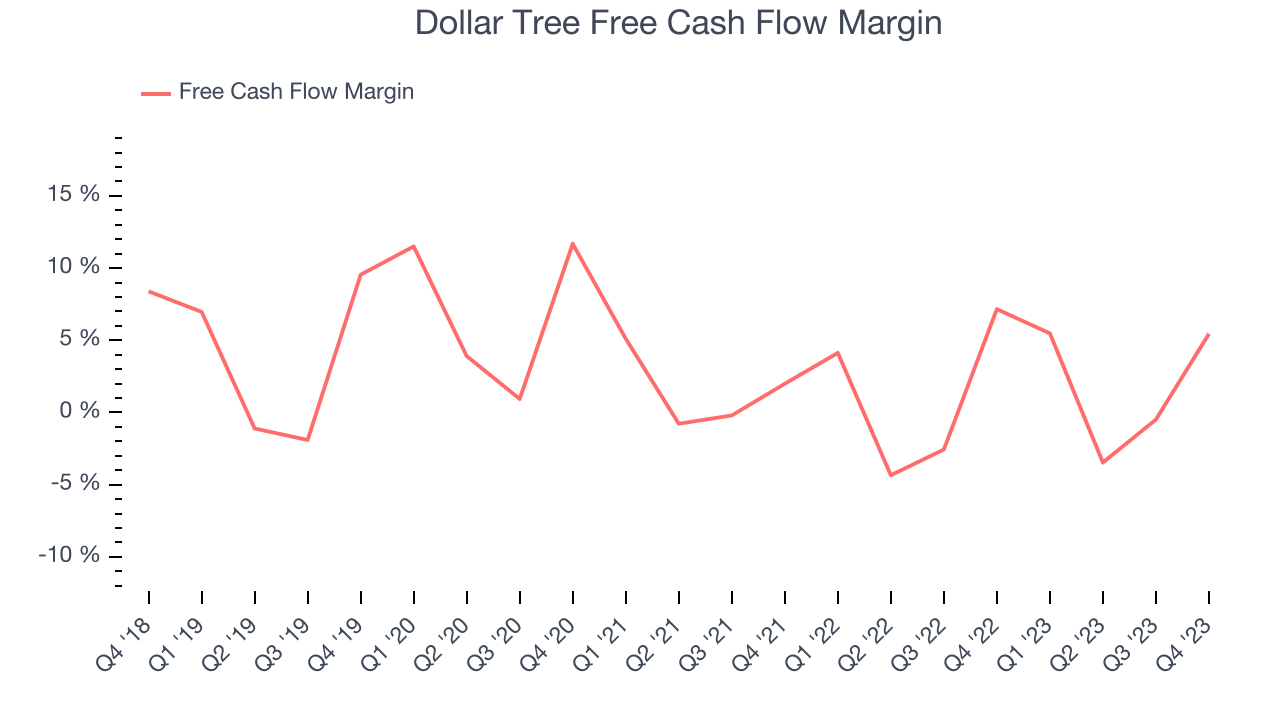
Over the last eight quarters, Dollar Tree has shown mediocre cash profitability, putting it in a pinch as it gives the company limited opportunities to reinvest, pay down debt, or return capital to shareholders. Its free cash flow margin has averaged 1.6%, subpar for a consumer retail business. Dollar Tree's margin has also been flat during that time, showing the company needs to take action and improve its cash profitability.
Return on Invested Capital (ROIC)
EPS and free cash flow tell us whether a company was profitable while growing revenue. But was it capital-efficient? A company’s ROIC explains this by showing how much operating profit a company makes compared to how much money the business raised (debt and equity).
Dollar Tree's five-year average ROIC was 7%, somewhat low compared to the best retail companies that consistently pump out 25%+. Its returns suggest it historically did a subpar job investing in profitable business initiatives.
The trend in its ROIC, however, is often what surprises the market and drives the stock price. Unfortunately, Dollar Tree's ROIC over the last two years averaged 6.8 percentage point decreases each year. In conjunction with its already low returns, these declines suggest the company's profitable business opportunities are few and far between.
Key Takeaways from Dollar Tree's Q4 Results
It was encouraging to see Dollar Tree slightly beat analysts' revenue guidance expectations. On the other hand, its full year revenue and EPS guidance both missed Wall Street's estimates. Overall, this was a mixed quarter for Dollar Tree. The company is down 6.5% on the results and currently trades at $140.06 per share.
Is Now The Time?
Dollar Tree may have had a tough quarter, but investors should also consider its valuation and business qualities when assessing the investment opportunity.
We cheer for all companies serving consumers, but in the case of Dollar Tree, we'll be cheering from the sidelines. Its revenue growth has been a little slower over the last four years, and analysts expect growth to deteriorate from here. And while its projected EPS for the next year implies the company's fundamentals will improve, the downside is its declining EPS over the last four years makes it hard to trust. On top of that, its relatively low ROIC suggests it has struggled to grow profits historically.
Dollar Tree's price-to-earnings ratio based on the next 12 months is 21.2x. While we've no doubt one can find things to like about Dollar Tree, we think there are better opportunities elsewhere in the market. We don't see many reasons to get involved at the moment.
Wall Street analysts covering the company had a one-year price target of $152.55 per share right before these results (compared to the current share price of $140.06).
To get the best start with StockStory, check out our most recent stock picks, and then sign up to our earnings alerts by adding companies to your watchlist here. We typically have the quarterly earnings results analyzed within seconds of the data being released, and especially for companies reporting pre-market, this often gives investors the chance to react to the results before the market has fully absorbed the information.
